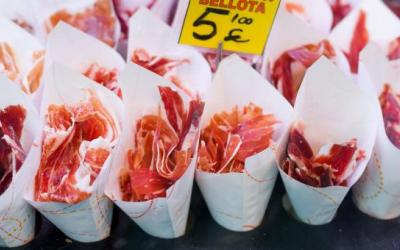Russian agricultural exports to China grew by 44% in 2022
According to preliminary data from the Federal Customs Service, over the past year, Russian exports of rapeseed oil to CHINA doubled in physical terms and 2.4 times in monetary terms. Thus, almost 70% of all Russian rapeseed oil exports went to the East Asian country. “The growth in supply volumes is associated with an increase in rapeseed production in 2022: if the gross production of rapeseed in 2021 was only 2.7 million tons, then in 2022 the volumes increased to 4.5 million tons. And in the current conditions, the Chinese market is becoming a priority for our country,” says Sergey Tuchin, DIRECTOR General of the Rosraps Association.
In 2022, shipments of fish and seafood from RUSSIA to China increased significantly, the total volume of which exceeded 500 thousand tons. Including the physical volume of frozen fish exports increased by 46%, and revenue - by 68%. Shellfish were exported to China by 30% more than in 2021. “The growth of exports to China is due to several factors,” commented the press service of the Federal Agency for Fishery. – Firstly, it is the growing interest on the part of the PRC in products manufactured by Russian companies (frozen fish, fillets, crabs). The second is the removal of covid restrictions, the third is the redirection of the released volumes of exports in connection with the imposition of sanctions by unfriendly countries.”
Shipments of soybeans to China remained at the level of 2021, while EXPORT revenue increased by 55%. Sales of vegetable meal and cake to China in 2022 increased by 16 times in physical terms, and by 7.7 times in value terms.
Poultry MEAT was delivered to China last year by 139 thousand tons, which is 11% more than in 2021. In monetary terms, the growth rate was 53%. Thus, China retained its leadership among buyers of Russian poultry meat: about 40% of the total physical volume of Russian poultry meat exports last year came from this country (in 2021 - 42%).
“The growth in shipments to China is primarily due to the fact that in 2022 the country lifted excessive restrictions and product verification procedures as part of the covid-19 policy, while the control of imported products for compliance with organoleptic indicators was strengthened. These changes in the regulations for the work of the authorized bodies of the PRC were expected, and in anticipation of this, Russian manufacturers have strengthened internal requirements for products supplied to China,” explains Sergey Lakhtyukhov, Director General of the National Union of Poultry Breeders. In addition, he noted the increased volume of poultry meat production in Russia and, as a result, an increase in the supply of products that are in demand on the Chinese market. At the same time, during the past year, it was possible to overcome a significant part of the problems
China is the world's largest producer of many types of agricultural products and occupies a leading position in the production of vegetables, grains and fruits. The basis of China 's agriculture is crop production, which accounts for about 70% of all agricultural production. At the same time, China is the world's largest food importer. According to the ITC Trade Map, in 2021 the Republic increased the value of imports of agricultural products by 29%, to $209 billion and surpassed the United States for the first timeby this indicator. Soybeans (26%), pork and edible offal of pigs (6.2%), beef and edible offal of cattle (6%), corn (3.9%) and crustaceans (3.3%) dominated in the value structure of imports of agricultural products of China. %) The main suppliers of agricultural goods to China in 2021 were Brazil, the usa and Thailand.
Forecasts for 2023
According to Agroexport, Russia has the potential to further expand food supplies to China. Among the most promising categories are fish and seafood, cereals, meat products and vegetable oils.
Thus, trade and economic cooperation between Russia and China in the field of fishing and logistics continues to develop, showing good results, the Federal Agency for Fishery emphasizes. “It is very important for the domestic fishing industry to supply surplus products to foreign markets, with a focus on moving away from the raw material orientation and increasing the value of exports through the supply of deep-processed products,” they emphasize. In 2022, Russia and China signed a roadmap to increase bilateral trade in goods and services to $200 billion by 2024. “Based on this, it can be expected that the volume of supplies of fish and fish products may increase. In addition, the Federal Agency for Fisheries is developing a digital ecosystem together with Chinese importers in order to digitally issue permit certificates for the export of fish and fish products,
There are significant opportunities to further increase sales to China of the main types of vegetable oils, including rapeseed. “The export potential of rapeseed products to China is huge,” Sergey Tuchin is sure. “But the expansion of export opportunities directly depends on the growth of rapeseed production in the Siberian Federal District and the active inclusion of rapeseed in the crop rotation in the Far East, where soybeans traditionally occupy a significant share.”
Preservation of the positive dynamics of exports to China is predicted in the segment of poultry meat. “This year we expect continued growth in supplies. In our opinion, several factors will contribute to this. Firstly, the departure of the Chinese leadership from the policy of zero tolerance, the restoration of the rhythm of the work of ports and, in general, supply chains. Secondly, we see a continuing decline in shipping costs. In addition, some decrease in supplies from the United States, which ranks second in terms of supplies to China, is possible against the backdrop of tougher mutual rhetoric,” Sergey Lakhtyukhov estimates. According to him, there are also expectations for the opening of new production sites for deliveries to China and their inclusion in the CIFER system.
* data from the Federal Customs Service and Rosstat in the form 8-VES for January-December 2022



























































